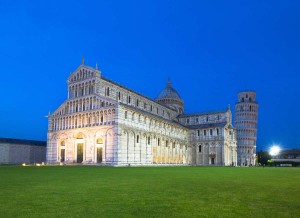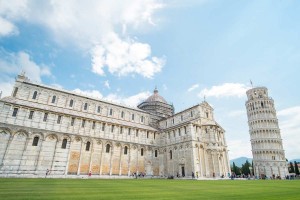
©Bigstock.com/ViFi
When hearing the name Pisa, you’re probably thinking about one particular tower that is everything but straight. Sure, the Leaning Tower is the landmark of the Tuscan city for many tourists, yet only one of many sights on the cathedral square Piazza del Duomo. Also known as Piazza dei Miracoli (“Square of Miracles”), it is home to what are most likely the grandest and most important sights of Pisa having had a major impact on epic Italian architecture and art far beyond the Middle Ages. The square was even named UNESCO World Heritage Site as early as 1987.
Peripheral location, huge influence
Usually, it’s historic city centres and medieval centres make the UNESCO list. Piazza del Duomo, too, takes up a major role in Pisa’s city life, yet is “only” located at the northwest-most edge of the city centre. While this peripheral location seems unusual, it actually makes perfect sense. You will probably visit the cathedral square quite purposefully for a sightseeing tour, whereas the actual historic city centre is situated comparatively quietly displaying distinctive Tuscan flair.
The buildings themselves were mostly built during the 11th and 12th century. They have an almost hypnotic effect to this very day attracting countless visitors from all around the world. The architectural style of the individual churches and monuments around the grassed area near the old town fortification would soon make its way up and down the country. Numerous towns and constructors tried to emulate the special, almost radiant appearance of the miracle square until far into the 14th century. You’d like to know which buildings exactly you can find here? Well then, time to take a look at the highlights on the Piazza del Duomo in Pisa!
Pisa Cathedral

©Bigstock.com/moomusician
You’ll be astonished to hear that constructions of the cathedral of the Archdiocese of Pisa lasted over 200 years. Standing in front of it you probably won’t notice as architects relied on a consistent façade design using the same building material – Carrara marble – for the entire time. It should come as no surprise that Siena and Florence, among other towns, were inspired by this monumental Christian structure.
To this day the cathedral cannot be dated precisely. That’s a particular shame as the façade marks the significant transition from smooth walls to a sculpturally designed display area, a genuine novelty in European architecture. As such, there’s a wealth of theories about the outer wall designed in multi-colour marble, mosaics and bronze objects. Unfortunately, a severe fire destroyed most of the interior in 1595. The gold-plated panelled ceiling, for example, was installed during restauration works. Splendid frescoes and mosaics in the cupola and on the pulpit complement the monumental marble pillars quite formidably.
Leaning Tower of Pisa
The foundation for a freestanding bell tower, intended to be part of Pisa Cathedral, was laid on 9 August 1173. Twelve years later, constructions had just reached the third floor, the campanile began to lean towards the southeast resulting in a hundred-year construction break. It was only around 200 years later that the Leaning Tower of Pisa, now the city’s landmark, was finished in a modified manner.
But why is the tower leaning anyway? It’s likely due to the poor sand and bog ground. Furthermore, it stands at the edge of a former island that was next to the ancient port basin. The tower’s inclination angle is now around four degrees, the pendulum inside it thus almost touches a side wall. Tours are possible again now – 15 minutes for no more than 40 people at once. Let’s hope you’re not seasick!
Baptistery
Pisa Cathedral was to get its own small baptistery in mid-12th century; small in comparison to the cathedral itself, that is. The abundant Romanesque-style church on a circular foundation is quite impressive in its own right, just with its richly adorned façade alone. The busts above the arcades of the largest Christian baptistery in the world depict apostles and prophets. However, they are replicas of Giovanni Pisano’s originals. Never-ending stairs lead you right beneath the cupola roof giving you an amazing view of da Como’s baptismal font. And don’t even get us started on the echo…
Other highlights on the Piazza del Duomo
These three main buildings aside, you’ll find many other exciting highlights on Pisa’s cathedral square. We handpicked a few of our favourites for you:
- Camposanto Monumentale: Piazza del Duomo features a monumental cemetery at its north end. According to lore, it was built around sacred soil brought back from the Holy Land by crusaders. A Gothic façade with blind arcades leads you inside this complex. See several carefully restored frescoes and late-antiquity sarcophagi which have been serving as burial places for nobility since the Middle Ages in the cloister.
- Palazzo dell’Opera: This complex of buildings on the northeast of the square united various buildings of later periods. The individual houses of the Opera Palace were built between the 14th and the 19th century originally serving as dwellings for the cathedral complex employees. These days, only a select few rooms are used as offices while others were opened to the public for the very time only a few years ago.
- Ospedale Nuovo di Santo Spirito: The “New Hospital of the Holy Spirit” was built in place of an older, smaller hospital on the southeast-most part of the square in 1257. It was intended to provide sanctuary to the poor and sick, to orphans and pilgrims. However, the hospital behind the Gothic façade has since been replaced by the Museo delle Sinopie. Here you gaze at the unearthed fresco sinopers – a sort of fresco sketch made with reddish brown natural colour – of the Camposanto Monumentale in wonder.
Pisa remains wildly fascinating to this very day. This stunning, impressive city with its slightly remote city centre still manages to inspire and amaze visitors. Piazza del Duomo is way more than “just” the impressive Leaning Tower, as you’ll quickly realise during your visit. Be enchanted by the monumental cathedral complex with its lavish facades and awesome buildings – ZAINOO wishes you lots of fun with your journey to the heart of Tuscany!